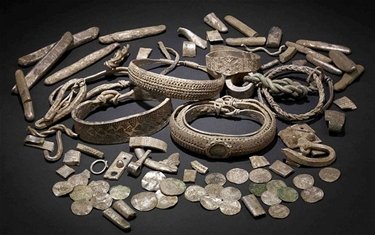Viking Hoard Found by Metal Detector in Silverdale, Lancashire
Archaeology, England, Lancashire, Silverdale, Treasure, Vikings
Darren Webster was meant to be going back to work after dropping his son off at home when, on a whim, he stopped by a field and decided to have a quick forage with his metal detector.
Within 20 minutes he made a discovery that was to introduce a new name to the turbulent history of medieval England.
One of the objects in a hoard of silver buried one metre down in the earth was a coin marked with the name of Airedeconut, thought to refer to Harthacnut, a previously unrecorded Viking king powerful enough to have his own currency in 10th-century Northumbria.
Mr Webster, who has a stone tile workshop in Yealand Conyers, Lancashire, said that he had permission to search in the field near his home in Silverdale but did not choose it for any particular reason.
“My machine was telling me that I’d found some kind of silver. So I was slightly disheartened when I saw a lead pot. It was as I was lifting it that silver pieces started falling out of it.”
Once the lead container had been prised open there were 201 silver objects, including 27 coins, ten arm-rings, six brooch fragments, two finger rings, a fine wire braid and 14 ingots.
There were also 141 fragments of metal known as hacksilver, which would have been used for barter.
Gareth Williams, curator of early medieval coins at the British Museum, where the discovery was announced yesterday, said that the hoard would have been worth a midsized herd of cows in the 10th century, and would probably fetch a “high five-figure sum” today.
The exact value will be determined by a panel of experts in the spring, when museums will be allowed to bid for it. The Lancaster City Museum has already expressed an interest.
Under the Treasure Act, Mr Webster will be awarded half the value of the hoard, and the remainder will be given to the owner of the field, who has asked to remain anonymous.
Why someone hid a small fortune is a mystery, but burying treasure is usually an attempt to keep valuables safe in uncertain times.
“It is a period of political instability,” said Dr Williams. “The Vikings of Dublin were expelled and came to the North of England. There was also the Battle of Tettenhall, on the outskirts of Wolverhampton, where several northern kings were killed.”
————————–
The hoard was placed in a lead box and buried underground at a time when the Anglo-Saxons were attempting to wrest control of the north of the country from the Vikings.
Yesterday, the central London museum unveiled the hoard, the fourth largest ever found, which included Anglo-Saxon, Anglo-Viking, German and Islamic coins.
In total there were 201 silver objects, including the 27 coins which date the burial around 900AD, around the time the Vikings had been expelled from Dublin and were fighting the Anglo-Saxons to keep control of the north of England.
It also includes also coins from the time of Alfred the Great, who reigned from 871 to 899, and from the Viking kingdom of Northumbria.
One silver denier, bears the name Charles. Others bear the name Airdeconut, a Viking ruler in northern England.
Officials said the inscription Airdeconut, appeared to be an attempt to represent the Scandinavian name Harthacnut.
They said this was because many Vikings had converted to Christianity within a generation of settling in Britain.
On the other side were the words DNS (Dominus) REX, which was arranged in the form of a cross.
“The design of the coin relates to known coins of the kings Siefredus and Cnut, who ruled the Viking kingdom of Northumbria around AD900, but Harthacnut is otherwise unrecorded,†a museum spokesman said.
“It is a very significant find. It is a very large haul and it is the fourth large Viking find in the UK. Because it is recently discovered there is lots of research to be done.â€
Experts believe the hoard, which also includes 10 arm rings, two finger rings, 14 ingots, six brooch fragments and a fine wire braid which may have been worn as a necklace, could have been buried by a Viking warrior before he went into battle.
The collection of 10 bracelets and other jewellery are thought to have been worn to signify rank of the influential owner.
Dr Gareth Williams, the curator of early medieval coins at the museum, said: “Some of the coins reinforce the things we already know but with some of them it fills in the gaps where we didn’t even know we had gaps.
“It is always great when you get a new piece of evidence. This is the first new medieval King for at least 50 years and the first Viking King discovered since 1840. It is a very exciting find.”
It was found in September by Darren Webster, 39 using a metal detector on land around Silverdale, in north Lancashire.
Hat tip to Karen L. Myers.




